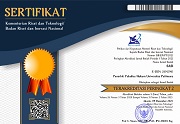Pelaksanaan Eksekusi Putusan Pengadilan Tata Usaha Negara Di Era Otonomi
 )
)
(1) Program Doktor Ilmu Hukum Pascasarjana Universitas Borobudur, Indonesia
 Corresponding Author
Corresponding Author
Abstract
The execution of the State Administrative Court Decision which has permanent legal force (inkracht van Gewijsde) in the era of autonomy is as wide as possible, and begins with the breakdown of the paradigm of regional autonomy in the 1945 Constitution of the Republic of Indonesia. Article 18, Article 18A and Article 18B, the implementation of regional government is based on the principles that become the normative basis. State Administrative Court decisions that cannot be executed have caused pessimism and apathy in society. The problem is that there is no executive power in the Law Number 5 of 1986 concerning the Regulation of State Administration. This condition is an alarming fact that the existence of a State Administrative Court Decision has not been able to bring justice to the public in the administrative sphere of government. The principle of the existence of a State Administrative Court Decision, to place judicial control in the implementation of good governance becomes biased in the Indonesian constitutional system.
Keywords
DOI
10.47268/sasi.v25i1.151
Published
2019-08-24
How To Cite
@article{SASI151,
author = {Dezonda Pattipawae},
title = {Pelaksanaan Eksekusi Putusan Pengadilan Tata Usaha Negara Di Era Otonomi},
journal = {SASI},
volume = {25},
number = {1},
year = {2019},
keywords = {Execution; State Administrative Court; Autonomy},
abstract = {The execution of the State Administrative Court Decision which has permanent legal force (inkracht van Gewijsde) in the era of autonomy is as wide as possible, and begins with the breakdown of the paradigm of regional autonomy in the 1945 Constitution of the Republic of Indonesia. Article 18, Article 18A and Article 18B, the implementation of regional government is based on the principles that become the normative basis. State Administrative Court decisions that cannot be executed have caused pessimism and apathy in society. The problem is that there is no executive power in the Law Number 5 of 1986 concerning the Regulation of State Administration. This condition is an alarming fact that the existence of a State Administrative Court Decision has not been able to bring justice to the public in the administrative sphere of government. The principle of the existence of a State Administrative Court Decision, to place judicial control in the implementation of good governance becomes biased in the Indonesian constitutional system.},
issn = {2614-2961}, pages = {92--106} doi = {10.47268/sasi.v25i1.151},
url = {https://fhukum.unpatti.ac.id/jurnal/sasi/article/view/151}
}
Basah, Sjachran. (2001). Perlindungan Hukum Terhadap Sikap Tindak Administrasi Negara, Bandung: Alumni.
Friedrich, Carl C. (1999). Constitutional Government and Democracy: Theory and Practice in Europe and America, 5th ed. Weltham Mass, Blaidsdell Publishing Company.
Gadjong, Agussalim Andi. (2007). Pemerintahan Daerah, Kajian Politik dan Hukum, Ciawi-Bogor: Ghalia Indonesia.
Hatta, Mohammad, (2000). Kumpulan Karangan (I), Jakarta: Bulan Bintang.
Harahap, Zairin. (2001). Hukum Acara Peradilan Tata Usaha Negara, Jakarta: Raja Grafindo.
Indroharto. (1999). Usaha Memahami Undang-undang Tentang Peradilan Tata Usaha Negara buku I beberapa Pengertian Dasar Hukum Tata Negara, Jakarta: Pustaka Sinar Harapan.
Marbun, S F. (2003). Peradilan Administrasi dan Upaya Administratif di Indonesia, Yogyakarta: Liberty.
Martiman, Prodjohamidjojo. (2005) Hukum Acara Pengadilan Tata Usaha Negara, Jakarta: Raja Ghalia Indonesia.
Manan, Bagir. (2005). Otonomi Daerah-Filosofi, Sejarah Perkembangan dan Problematika, Yogyakarta: Pustaka Pelajar.
Muljadi, Arief, (2005). Landasan dan Prinsip Hukum Otonomi Daerah Dalam Negara Kesatuan Republik Indonesia, Cet. I, Jakarta: Prestasi Pustaka Publisher.
Marzuki, M. Laica. (2006). Berjalan-jalan di Ranah Hukum, Pikiran-pikiran Lepas, Jakarta: Konpress.
Nazroen, M. (1999). Masalah-Masalah Sekitar Otonomi Daerah, Jakarta: Wolters.
Pot, Van der, (1990). Handboek van het Nederlands Staatsrecht, WEJ Tjeenk Willink Zwolle.
Prinst, Darwin. (2005). Strategi Menangani Perkara Tata Usaha Negara, Bandung: Citra Aditya Bakti.
Rasyid, Roihan A. (2001). Hukum Acara Peradilan Agama, Jakarta: Raja Grafindo Persada.
Salim, Amarullah. (2000). Peranan Peradilan Tata Usaha Negara sebagai Pengawasan Yusticial Terhadap Pemerintah Berdasarkan Asas-Asas Umum Pemerintahan Yang Baik Dari Suatu Negara Hukum, Jakarta: Lembaga Administrasi Negara, Departemen Kehakiman.
Syafrudin, Ateng (2000). Pengaturan Koordinasi Pemerintahan di Daerah, Bandung: Tarsito.
Soehino. (2000). Perkembangan Pemerintahan Daerah, Yogyakarta: Liberty.
Saleh, Syarif. (2003). Otonomi dan Daerah Otonom, Jakarta: Endang.
Wade, H. W. R. (2006). Hukum Administrasi Negara, Jakarta: Raja Grafindo Persada.
Mawardi, Oentarto S. (2002). Setahun Implementasi Kebijaksanaan Otonomi Daerah di Indonesia, Makalah Seminar Nasional Setahun Implementasi Kebijakan Otonomi Daerah, Program Pascasarjana UGM, Yogyakarta.
Ndraha, Taliziduhu. (2000). Otonomi Daerah, Desentralisasi dan Pembangunan, Makalah.
Hajhon, Philipus M. (1990). Fungsi Normatif Hukum Administrasi Dalam Mewujudkan Pemerintah Yang Bersih, Pidato Penerimaan Jabatan Guru Besar Pada Fakultas Hukum UNAIR, Surabaya.
Hadjon, Philipus M. (2004). Penerapan Eksekusi Putusan PTUN Terhadap Pejabat TUN di Daerah, Disampaikan pada Workshop tentang Penerapan Eksekusi Putusan TUN dalam kaitannya dengan pelaksanaan otonomi daerah, Jakarta, 28 Agustus 2004.
Cited-By:
1. Sanksi Terhadap Pelanggaran Izin Pengelolaan Sampah
Meyliana Pintubatu, Hendrik Salmon, Dezonda Rosiana Pattipawae
Jurnal Saniri vol: 4 issue: 1 first page: 25 year: 2023
Type: Journal [View Source]
2. Pembuktian Potensi Kerugian dalam Gugatan terhadap Keputusan Tata Usaha Negara
Rizky Ramadhan Baried
SASI vol: 27 issue: 3 first page: 346 year: 2021
Type: Journal [View Source]
| Dublin Core | PKP Metadata Items | Metadata for this Document | |
| 1. | Title | Title of document | Pelaksanaan Eksekusi Putusan Pengadilan Tata Usaha Negara Di Era Otonomi |
| 2. | Creator | Author's name, affiliation, country | Dezonda Rosiana Pattipawae; Program Doktor Ilmu Hukum Pascasarjana Universitas Borobudur; Indonesia |
| 3. | Subject | Discipline(s) | |
| 3. | Subject | Keyword(s) | Execution; State Administrative Court; Autonomy |
| 4. | Description | Abstract | The execution of the State Administrative Court Decision which has permanent legal force (inkracht van Gewijsde) in the era of autonomy is as wide as possible, and begins with the breakdown of the paradigm of regional autonomy in the 1945 Constitution of the Republic of Indonesia. Article 18, Article 18A and Article 18B, the implementation of regional government is based on the principles that become the normative basis. State Administrative Court decisions that cannot be executed have caused pessimism and apathy in society. The problem is that there is no executive power in the Law Number 5 of 1986 concerning the Regulation of State Administration. This condition is an alarming fact that the existence of a State Administrative Court Decision has not been able to bring justice to the public in the administrative sphere of government. The principle of the existence of a State Administrative Court Decision, to place judicial control in the implementation of good governance becomes biased in the Indonesian constitutional system. |
| 5. | Publisher | Organizing agency, location | Faculty of Law, Universitas Pattimura |
| 6. | Contributor | Sponsor(s) | |
| 7. | Date | (YYYY-MM-DD) | 2019-08-24 |
| 8. | Type | Status & genre | Peer-reviewed Article |
| 8. | Type | Type | |
| 9. | Format | File format | PDF (Bahasa Indonesia) |
| 10. | Identifier | Uniform Resource Identifier | https://fhukum.unpatti.ac.id/jurnal/sasi/article/view/151 |
| 10. | Identifier | Digital Object Identifier | 10.47268/sasi.v25i1.151 |
| 11. | Source | Title; vol., no. (year) | SASI; Vol 25, No 1 (2019): Volume 25 Nomor 1, Januari - Juni 2019 |
| 12. | Language | English=en | id |
| 13. | Relation | Supp. Files | |
| 14. | Coverage | Geo-spatial location, chronological period, research sample (gender, age, etc.) | |
| 15. | Rights | Copyright and permissions | Copyright: Authors who publish their manuscripts in this Journal agree to the following conditions: 1. The copyright in each article belongs to the author, as well as the right to patent. 2. Authors can enter into separate, additional contractual arrangements for the non-exclusive distribution of the journal's published version of the work (e.g., post it to an institutional repository or publish it in a book), with an acknowledgment of its initial publication in this journal. 3. Authors are permitted and encouraged to post their work online (e.g., in institutional repositories or on their website) before and during the submission process, as it can lead to productive exchanges, as well as earlier and greater citation of published work. 4. Authors have the right to self-archiving of the article (Author Self-Archiving Policy)
License: The SASI Journal is disseminated based on the Creative Commons Attribution-NonCommercial 4.0 International license terms. This license allows anyone to copy and redistribute this material in any form or format, compose, modify, and make derivatives of this material for any purpose. You cannot use this material for commercial purposes. You must specify an appropriate name, include a link to the license, and certify that any changes have been made. You can do this in a way that is appropriate but does not imply that the licensor supports you or your use.
|
Copyright (c) 2019 Dezonda Rosiana Pattipawae

This work is licensed under a Creative Commons Attribution-NonCommercial 4.0 International License.
Cited-By:
1. Sanksi Terhadap Pelanggaran Izin Pengelolaan Sampah
Meyliana Pintubatu, Hendrik Salmon, Dezonda Rosiana Pattipawae
Jurnal Saniri vol: 4 issue: 1 first page: 25 year: 2023
Type: Journal [View Source]
2. Pembuktian Potensi Kerugian dalam Gugatan terhadap Keputusan Tata Usaha Negara
Rizky Ramadhan Baried
SASI vol: 27 issue: 3 first page: 346 year: 2021
Type: Journal [View Source]

 : 8466 times
: 8466 times Download : 73173 times
Download : 73173 times
















